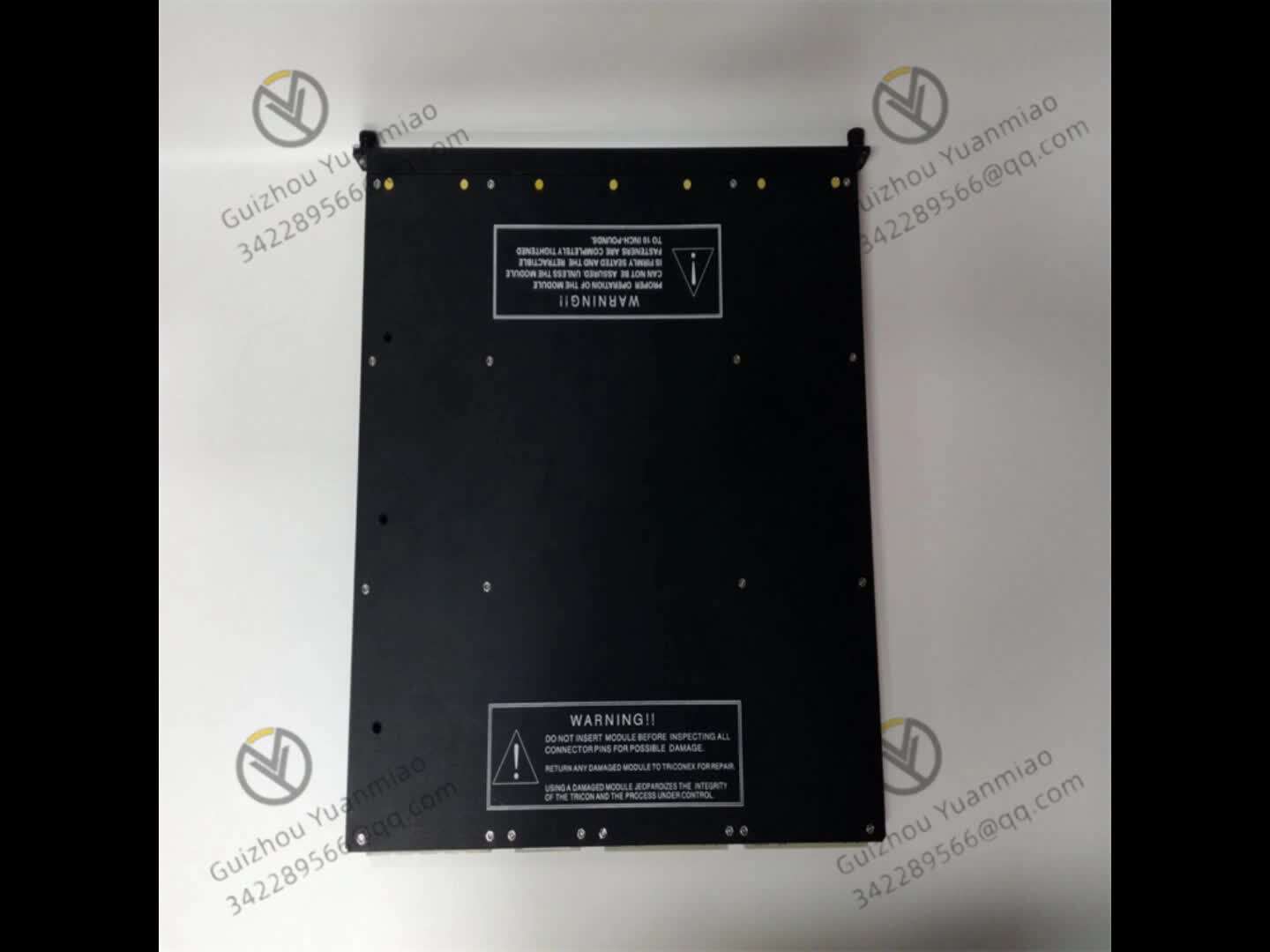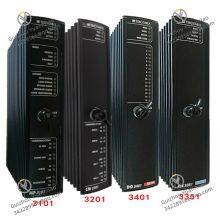Material
Other, Global universal model
Condition
Other, Global universal model
Task
Other, Global universal model
Mathematical Model
Other, Global universal model
Signal
Other, Global universal model
Customized
Non-Customized
Structure
Other, Global universal model
Operating Temperature
-40℃~70℃
Relative Humidity
5% - 95% (non-condensing)
Storage Temperature
-40℃~85℃
Dimensions
160mm×120mm×80mm
I. Overview
The TRICONEX DI3361 is a digital input module specifically designed for safety-critical industrial automation systems. As a core I/O component of the TRICONEX Triple Modular Redundancy (TMR) control system, its primary function is to accurately collect discrete digital signals from industrial sites (such as equipment status switches, limit signals, alarm contacts, etc.) and transmit them to the control system, providing a true and reliable digital signal source for equipment operation status monitoring and logical control decision-making.
The DI3361 plays a particularly crucial role in fields with extremely high requirements for system safety and availability, such as petrochemicals, oil and gas extraction, and nuclear power plants. For example, in the catalytic cracking unit of a large refinery, the unit's Emergency Shutdown System (ESD) needs to receive key digital quantities in real time, such as valve switch status and pressure switch contact signals. The DI3361 can stably collect these signals in harsh environments with high temperatures and heavy dust, ensuring that the ESD system promptly determines whether the equipment is within a safe operating range and avoiding safety accidents caused by signal collection errors. In the auxiliary control system of a nuclear power plant, this module can collect signals such as pump set start-stop status and gate limit signals, providing data support for the stable operation of nuclear facilities. Its redundant design and anti-interference capability can effectively cope with signal fluctuations under extreme working conditions, ensuring continuous fault-free operation of the system.
II. Core Features
(1) High Channel Density and Flexible Signal Adaptation
The DI3361 is equipped with 32 independent digital input channels. A single module can meet the centralized collection needs of multiple devices and multiple signal points, significantly reducing the number of modules in the control cabinet and the complexity of wiring. This module supports dual voltage level inputs of 24V DC/48V DC, enabling flexible adaptation to the signal specifications of different on-site devices. For instance, for proximity switch signals powered by 24V DC or travel switch signals driven by 48V DC, there is no need to configure additional signal conversion modules. Adaptation can be achieved directly through module hardware DIP switches or software configuration, reducing system integration costs and potential fault points.
In the robot workstation of an automobile welding workshop, more than 20 fixture clamping status switches and safety door interlock signals in the workstation can be centrally collected by a single DI3361 module, without the need to split them into multiple modules. This not only simplifies wiring but also facilitates operation and maintenance personnel to quickly locate signal links.
(2) Triple Modular Redundancy Design Ensures Safety and Reliability
As a supporting module for the TRICONEX TMR system, the DI3361 adopts a triple modular redundancy design for signal collection and transmission that is consistent with the system architecture. Each input signal undergoes triple modular processing through independent signal conditioning circuits, isolation circuits, and collection channels. The redundant logic inside the module performs consistency verification on the three sets of collected data. If a single channel fails, the system can automatically shield the abnormal data and make judgments based on the other two sets of normal signals, ensuring uninterrupted and error-free signal collection.
In the control system of a natural gas long-distance pipeline pressure station, the pipeline pressure high-limit switch signal is collected in a triple modular manner through the DI3361. Even if a single channel of the module generates a false alarm due to electromagnetic interference, the redundant logic can quickly identify and eliminate the anomaly, preventing the control system from mistakenly triggering the action of the emergency shut-off valve and ensuring the continuity of pipeline transportation.
(3) Enhanced Anti-Interference and Electrical Isolation
Targeting the complex electromagnetic environment of industrial sites, the DI3361 adopts a channel-level photoelectric isolation (isolation voltage ≥ 2500Vrms) and all-metal shielded housing design. Each input channel is completely isolated from the internal circuit of the module, which can effectively suppress ground loop interference and common-mode interference. The shielding effectiveness of the metal housing is ≥ 40dB, which can resist radiated interference generated by industrial equipment (such as frequency converters and motors), ensuring that signal collection accuracy is not affected in strong electromagnetic environments like steel plants and non-ferrous metal smelters.
For example, in the continuous caster control system of a large steel plant, the strong electromagnetic radiation generated by the operation of the continuous caster motor is likely to interfere with surrounding signals. However, the DI3361 can stably collect mold liquid level switch and roller table limit signals, with a collection error rate of less than 0.01%, which is much lower than the 0.1% error threshold of traditional digital input modules.
(4) Real-Time Diagnosis and Fault Early Warning
The module integrates a full-channel online diagnosis function, which can real-time monitor the signal status (such as open circuit, short circuit, overvoltage) of each input channel and transmit the diagnosis results to the controller and upper computer through the TRICONEX system bus. When an open-circuit fault occurs in a certain channel (such as a broken sensor cable), the module can trigger a fault alarm within 10ms and clearly mark the fault channel number. Operation and maintenance personnel do not need to check each channel one by one, but can quickly locate the fault point, reducing the Mean Time To Repair (MTTR) to less than 15 minutes.
In the aseptic filling production line of the pharmaceutical industry, if a short-circuit fault occurs in the channel for collecting the filling valve status signal by the DI3361, the module can immediately report the fault. The control system then promptly pauses the filling process, avoiding unqualified drug packaging caused by signal anomalies and reducing production losses.

III. Technical Specifications
(1) Electrical Parameters
(2) Mechanical and Environmental Parameters
Overall Dimensions: 160mm×120mm×80mm (Length×Width×Height), compatible with TRICONEX standard racks, installed with 2U height
Weight: Approximately 0.8kg, lightweight design facilitates module insertion/extraction and cabinet layout
Operating Temperature Range: -40℃~+70℃, meeting the usage requirements of extremely cold areas (such as northern oilfields) and high-temperature workshops (such as glass factories)
Storage Temperature Range: -40℃~+85℃, adapting to long-distance transportation and storage environments
Protection Level: IP20 (front panel), suitable for installation in industrial control cabinets
Vibration Resistance: 5g acceleration (10Hz~2000Hz), complying with IEC 60068-2-6 standard
(3) Performance Parameters
Signal Response Time: ≤1ms (from signal trigger to valid module output)
Diagnostic Coverage: ≥99.9% (channel-level fault diagnosis)
MTBF (Mean Time Between Failures): ≥1,000,000 hours (complying with MIL-HDBK-217 standard, at 25℃ environment)
Communication Interface: Compatible with TRICONEX TMR system bus, data transmission rate ≥100Mbps
IV. Functions and Working Principles
(1) Digital Signal Collection Process
Signal Access and Isolation: Digital signals from industrial sites (such as switch contact signals) are connected to the corresponding channels of the DI3361 through shielded cables. Each signal first passes through a photoelectric isolation circuit to achieve electrical isolation from the internal power supply and control circuit of the module, preventing external interference from entering the core circuit of the module.
Signal Conditioning and Detection: The isolated signal enters the channel-level conditioning circuit. Spike pulse interference is suppressed through current-limiting resistors and filter capacitors. Then, a high-speed comparator converts the analog signal into a standard digital level (high level ≥18V DC, low level ≤5V DC) and detects the signal stability (debounce time can be set to 1ms~100ms via software).
Triple Modular Data Verification: Three independent collection units inside the module synchronously read the conditioned digital signals and transmit the three sets of data to the verification logic unit through the internal redundant bus. The verification unit performs "two-out-of-two" or "two-out-of-three" judgment on the three sets of data (according to system configuration). If the three sets of data are consistent, the valid signal is uploaded; if a single set of data is abnormal, the fault channel is marked and the output is generated using the two sets of normal data.
Data Transmission and Diagnostic Feedback: The verified valid signal is transmitted to the main controller through the TRICONEX system bus. At the same time, the diagnostic unit uploads the channel status (normal/open circuit/short circuit) in real time, and the working status of each channel is displayed on the upper computer monitoring interface, facilitating operation and maintenance personnel to grasp the module operation status in real time.
(2) Cooperative Working Mechanism with TMR System
As the I/O front-end of the TRICONEX TMR control system, the DI3361 realizes data interaction with the system's triple modular controllers (such as TRICON 5730) through a dedicated redundant bus:
Data Synchronization: The module synchronously sends the collected digital signals to the three controller units every 1ms. The controller performs consistency verification on the three sets of signals to ensure that the control logic is executed based on true and reliable input signals.
Fault Tolerance: If a single collection channel of the DI3361 fails, the controller can automatically ignore the abnormal data of that channel through the diagnostic information uploaded by the module and perform logical operations based on the other two sets of normal signals, preventing the system from triggering incorrect actions due to a single I/O fault.
Online Maintenance: Without shutting down the TMR system, the DI3361 can be replaced online via hot swapping. The system will automatically identify the new module and quickly complete parameter configuration and data synchronization. Signal collection remains uninterrupted during the replacement process, meeting the "non-stop maintenance" requirement of industrial production.











































